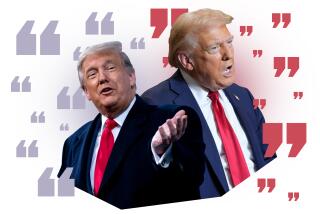Clinton Hedges on Middle-Class Tax Cut Stand
- Share via
WASHINGTON — Presumptive Democratic presidential nominee Bill Clinton has backed off the middle-class tax cut proposal that formed the center of his heated primary battles with former Massachusetts Sen. Paul E. Tsongas, aides said Thursday.
The move could help Clinton better promote his goal of reducing the federal deficit. And it could win him Tsongas’ active support. But for a candidate who already has had to battle voter doubts about his credibility, a change in such a well-advertised position almost certainly will bring new problems.
Speaking to reporters at a breakfast in Washington on Thursday, Clinton hedged his position, saying his campaign was revising its economic platform and would “have a statement next week sometime at the latest which will clarify what I’m going to do.”
Moreover, he insisted: “I’m not backing away from the idea of tax fairness.” But he clearly distanced himself from the tax plan he once touted, arguing that “the press and my political opponents always made more of the middle-class tax cut than I did.”
While that may well be true, the Arkansas governor used the middle-class tax cut to great effect in the New Hampshire primary and subsequent contests. Over and over, he hammered away at the contrast between his willingness to help the middle class--as exemplified by the tax-cut plan--and Tsongas’ desire for an across-the-board capital-gains tax cut that would mainly help the wealthy.
“I’ve offered a comprehensive plan,” Clinton’s advertisements in New Hampshire proclaimed. “It starts with a tax cut for the middle class.”
Now, with the economy beginning to show signs of improvement, Clinton aides argue the cut, which would have amounted to about $1 a day, would no longer do much to stimulate growth. Last weekend, when Democratic officials met to draft the party’s platform, Clinton aides quietly dropped the tax cut from the document.
Clinton’s platform still includes significant tax breaks for middle-class and poor families, his economic adviser, Rob Shapiro, stressed Thursday. One of Clinton’s ideas--an expanded tax break for families with children--would provide nearly all of its $25 billion in new tax breaks to families with annual incomes below $86,500. And the biggest benefits would go to those making less than $35,000 a year.
As an additional effort to shift the tax burden, Clinton proposes a tax increase on those earning more than $200,000 annually.
Given these proposals, Clinton’s move away from the middle-class tax cut is “more a shift in emphasis than a change in policy,” campaign press secretary Dee Dee Myers said.
But given his emphasis on the tax cut during the primaries, it offers a case study of two salient aspects of his campaign: his mastery of political tactics and the danger of such maneuvers in this year of anti-politics.
The tax cut was not part of Clinton’s original campaign plan. When he announced his candidacy last October, for example, he promised “middle-class tax relief” but did not promise a specific tax-rate cut.
But when the campaign reached New Hampshire, Clinton’s pollsters discovered that voters there wanted a specific set of answers to the state’s deep economic difficulties, Clinton pollster Stanley Greenberg said recently. In response, Clinton quickly developed detailed economic proposals, which included the middle-class tax cut. He mentioned it frequently as one of several steps he thought President Bush should take to end the recession.
Few economists thought the proposed cut--a 10% reduction in tax rates for those in the two bottom tax brackets--would accomplish much. Critics derided it as a dollar-a-day gimmick. Tsongas was particularly fierce, accusing Clinton--and other Democrats who endorsed the tax cut--of being guided solely by polling data and of “pandering” to voters.
From that point on, the tax cut took on a life of its own. Tsongas seized on the idea as a key distinction between Clinton and himself, often saying his opposition to it showed he was no “Santa Claus.” Clinton embraced the tax-cut plan ever more tightly, using it effectively against Tsongas in a series of Southern and Midwestern primaries.
Clinton did drop clues that he was not totally committed to it. Talking to New Hampshire voters, he repeatedly said he agreed with critics who doubted its economic benefit. The plan was not a matter of economics but of fairness, he would say, arguing that tax cuts in the 1980s mostly aided the rich.
And as soon as Tsongas dropped out of the race in March, Clinton began to de-emphasize the tax cut. In April, for example, he gave a major economics speech in Philadelphia and made no mention of it. Nor did he push the idea when he campaigned in California before the state’s June 2 primary. Then came the conspicuous absence from the platform.
Instead, Clinton has placed increasing emphasis on his family tax-credit plan and on tax credits designed to spur investment as he tries to focus his message more directly on the theme of improving long-term economic growth and producing jobs.
More to Read
Get the L.A. Times Politics newsletter
Deeply reported insights into legislation, politics and policy from Sacramento, Washington and beyond. In your inbox twice per week.
You may occasionally receive promotional content from the Los Angeles Times.











